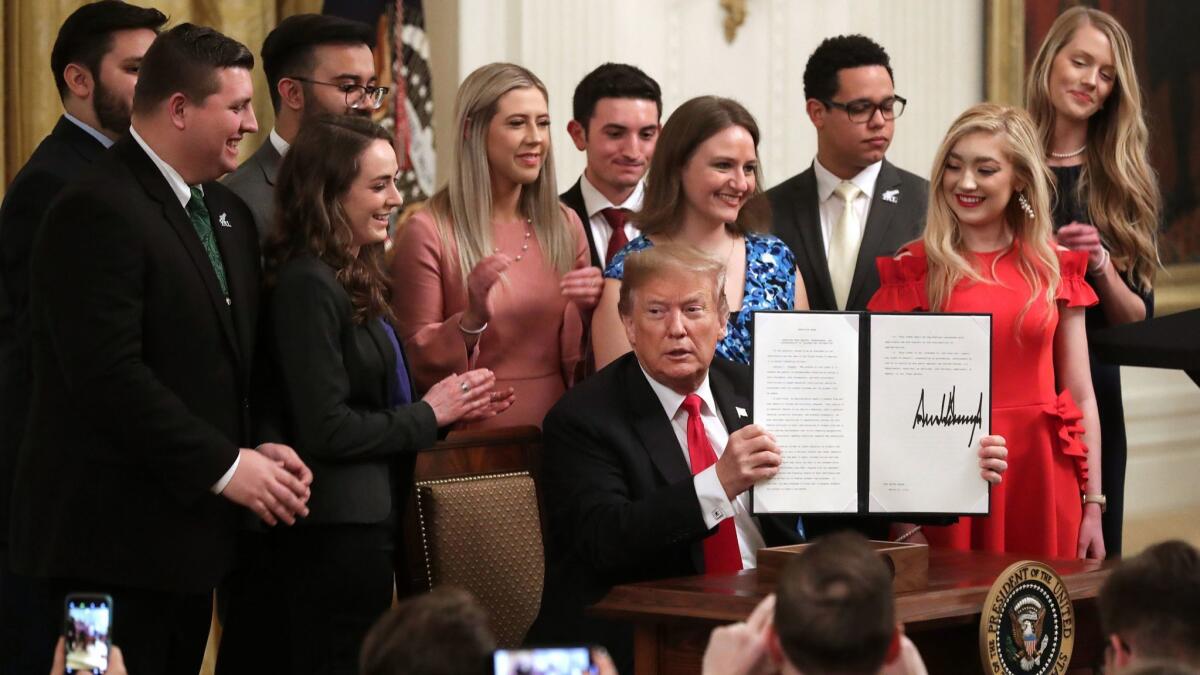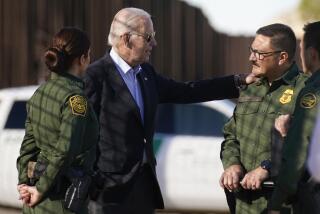Must Reads: What’s behind all those executive orders Trump loves to sign? Not much

Reporting from Washington — A seated President Trump handed commemorative pens to his wife, daughter and eight others who hovered around his desk, then theatrically held up for the cameras the latest executive order bearing his oversize signature.
He had done “something that people have wanted presidents to do for a long time,” a triumphant Trump told the applauding military families who packed the White House East Room. “We will now ensure that you have better access to federal jobs.”
Yet 11 months later, the four-page document he signed in May did no such thing.
The order provided no money, created no policies and added no hiring authority. It merely required federal officials to post notices on their websites and draft reports about an order signed a decade earlier by President George W. Bush, which allowed agencies to waive competitive hiring requirements for military spouses in some circumstances.
The substance mattered little, however. For a president who relishes pomp and shows of executive action, unchecked by Congress, signing ceremonies have become a hallmark, a way to convey accomplishment for a man who asserts he has done more than any president in history.
The Times reviewed 101 executive orders Trump has signed since inauguration day, and interviewed experts, advocates and administration officials about their effects. Many were geared toward favored political constituencies, including veterans, blue-collar workers and evangelical Christians. Few moved policy significantly; generally the orders created committees or task forces, demanded reports or pressed for enforcement of existing laws.
Trump’s boldest unilateral actions, the ones that have provoked the most vigorous objections to his use of presidential power, were not carried out through executive orders.
He did initially sign two executive orders to fulfill his campaign pledge to ban all Muslims from entering the country, but courts struck both down. A third version, revised again to pass court muster, was written as a proclamation; it was upheld by the Supreme Court. Trump’s recent effort to circumvent Congress to pay for a southern border wall, now the subject of another court challenge, is based on his Feb. 15 declaration of a national emergency.
The president’s executive orders are usually more modest, though Americans wouldn’t know it from the ceremonies the White House stages.
Many orders seek action from Cabinet secretaries, something Trump could easily accomplish with a phone call.
“You don’t really need an executive order for a lot of this stuff, but it makes for a good show,” said Elaine Kamarck, a Clinton administration veteran who is the director of the Center for Effective Public Management at the Brookings Institution.
“He even gives out pens, which is really sort of ridiculous,” she added, noting that past presidents reserved that tradition for signing momentous laws like the Civil Rights Act.
White House officials argue that Trump’s orders focus agency leaders on his priorities and that ultimately some have had broad impact, including the reduction of regulations across the federal government and the expanded availability of less expensive health plans that don’t offer a full set of benefits.
The formality of a written order, they say, can command attention across government.
The question is not whether Trump’s rhetoric “aligns with the legal language” in the orders, the White House said in a written response. Rather, the statement added, it’s what they have accomplished — “And they’ve done a lot!”
The Times review shows a different picture. A few of Trump’s orders have led to changes in policy. Many, however, have proved more ceremonial than substantive.
- At least 18 of the 101 orders created new task forces, councils or committees. Among them was an infrastructure council that disbanded within a month; members resigned in 2017 after Trump’s qualified criticism of white supremacists who marched in Charlottesville, Va. He issued two orders related to his unfounded claims of widespread voter fraud: One established a commission, the other disbanded it after bipartisan criticism.
- At least 12 included language such as “encourage” or “to the extent permitted by law,” underscoring the president’s lack of authority to make sweeping change without help from Congress.
- At least 15 reversed or curtailed Obama’s initiatives, notably the orders overturning environmental regulations. Those made for some of Trump’s most consequential actions even as they demonstrated a major drawback of executive orders — they can fairly easily be undone by a successor. Also, courts have blocked some environmental rollbacks.
- At least 43 called for agency reports or reviews, including one on historically black colleges and another on retirement savings rules. A few in this category led to significant changes, such as Trump’s order sharply shrinking the Grand Staircase-Escalante and Bears Ears national monuments in Utah that Presidents Clinton and Obama, respectively, had established.
- At least five related to members of the military, veterans and their families. Two called for plans and task forces on mental health and suicide among veterans. One established an accountability office at the Department of Veterans Affairs.
A fourth purported to create a job training program for veterans to enter the U.S. Merchant Marine, but it duplicated an existing “Military to Mariner” program.
It “complements what we’re doing,” Coast Guard Lt. Amy Midgett said.
In several cases, Trump has made broad claims about the impact of his executive orders that have proved false. He has repeatedly claimed that two of his orders require American-made steel in federal pipelines. In reality, they simply encouraged federal agencies to choose American companies for the product.
The order Trump signed on Inauguration Day, “to ease the economic burden” of President Obama’s healthcare law, was similarly toothless. Yet another told federal education officials to follow existing laws respecting local and state boards’ independence.
Trump’s 100th executive order, signed Thursday in an East Room event complete with a string quartet, followed up on a promise he made earlier in the month to a conservative conference, promising to force colleges to support free speech.
Trump called it “historic” and “groundbreaking.” Experts who read the text afterward said the ultimate impact was uncertain, given that public universities already must follow the 1st Amendment and it simply instructed private colleges to comply with their existing policies.
An official who briefed reporters beforehand struggled to explain the order and how the administration would enforce it.
Some of the orders seemed to have little purpose. One replaced the “White House Rural Council” with the “Interagency Task Force on Agriculture and Rural Prosperity” and two renamed a financial fraud task force and a council on physical fitness.
Another — one of the five related to the military — was the order for employing military spouses that simply promoted an existing program. It demonstrated that, for beneficiaries, executive orders can be a mixed blessing — bringing attention to issues but inviting complacency that the issues have been addressed.
“There was definitely quite a bit of excitement out there” about the military spouses order, “but what I was personally concerned about was that excitement leading to a ‘check the box’ mentality,” said Jennifer Akin, an applied research analyst for Blue Star Families, a military family advocacy organization.
Akin said the order brought needed attention to the issue but failed to address bigger obstacles, such as poor child-care options for military spouses.
Another favorite of Trump’s are his “buy American” orders.
After signing his first one in April 2017, he claimed at political rallies that it would require the Keystone XL and Dakota Access pipelines to be built with American steel. It did not. The order stated a broad goal and required the Commerce secretary to write a report.
Signing a second such order earlier this year, he insisted at a White House ceremony that the first was “having an incredible effect” on jobs for steel workers. The second order, to “encourage” agencies to use U.S. products “to the extent consistent with law,” has had no more impact than the first.
“I could encourage my kids to go to bed; doesn’t mean they will,” said Scott Paul, president of the Alliance for American Manufacturing, which represents steel workers and manufacturers. “It’s highly unlikely that an aspirational statement is going to produce actual jobs.”
Paul noted that Trump has senior advisors and Cabinet officials who have a record of opposing such requirements, including his acting chief of staff, Mick Mulvaney, and Transportation Secretary Elaine Chao.
Experts say Trump’s inability to stock his administration with experienced officials can diminish the impact of his orders; it takes committed, loyal advisors to oversee the laborious rule-making processes at government agencies.
“If you want it to actually happen, you’ve got to have people in the department who know what they’re doing,” said Kamarck.
Trump is hardly the first president to use executive orders to attempt to bypass Congress. Obama, frustrated by a Republican-controlled Congress’ obstruction in his final years, famously spoke of his desire to use a “pen and phone” to bypass Capitol Hill. Yet he seldom held signing ceremonies or made the kind of grand claims Trump has made.
Trump and his advisors speak often of his impatience with the legislative process, though he spent his first two years with a Congress run by his own party. After his first 100 days, he boasted that his signed orders were central to his “historic accomplishments.”
At the American Farm Bureau convention in Nashville last year, Trump hailed the “millions of hardworking Americans, completely forgotten,” and told the excited crowd that he had heard that broadband internet access was “a vital concern.” Then he pulled out a pen to sign “the first step to expand access to broadband internet in rural America — so you can compete on a level playing field.”
The crowd roared. Yet again, the order was modest, directing agencies to review procedures for placing private cell towers on public lands.
Christopher Mitchell, director of the Community Broadband Networks Initiative, said it has had practically no impact for the tens of millions of Americans who lack broadband.
“It’s not unlike trying to bail out a cruise liner with a pint glass,” he said. “These executive orders seem to be more about appearing to do something than really do something.”
Follow the latest news of the Trump administration on Essential Washington »
More to Read
Get the L.A. Times Politics newsletter
Deeply reported insights into legislation, politics and policy from Sacramento, Washington and beyond. In your inbox three times per week.
You may occasionally receive promotional content from the Los Angeles Times.











